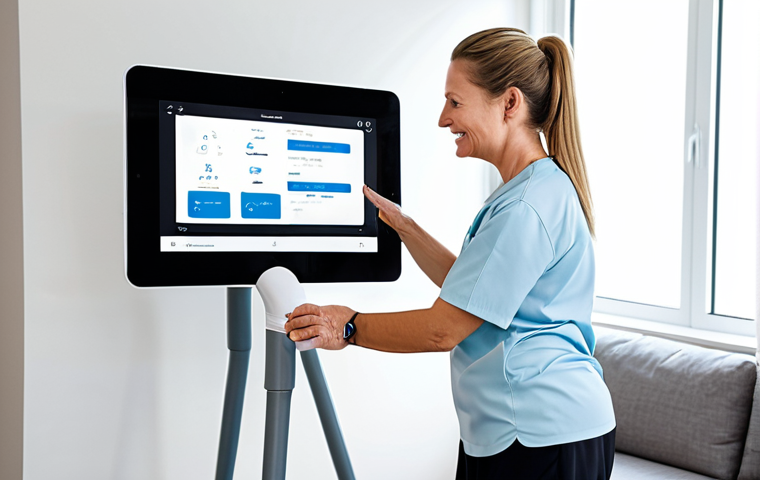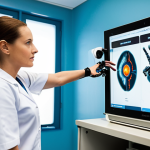Ever felt the frustration of an exercise routine that just isn’t working, or worse, aggravates an old injury? It’s a common scenario, and frankly, relying on generic online advice can often do more harm than good.
From my own years spent helping patients navigate their recovery journeys, I’ve seen firsthand that crafting truly effective exercise guidelines is far from a one-size-fits-all approach; it’s a deeply personalized science, an intricate dance between biomechanics and individual needs.
In today’s rapidly evolving healthcare landscape, the rise of wearable technology and AI-driven analytics is fundamentally transforming how physical therapists develop these bespoke plans, allowing for unprecedented precision and adaptive adjustments in real-time.
This isn’t just about prescribing reps and sets anymore; it’s about leveraging cutting-edge data to ensure every movement serves a purpose, preventing plateaus and maximizing patient outcomes, truly giving them the best possible shot at lasting health.
Let’s uncover the specifics of this vital process.
Beyond the Initial Assessment: Unearthing the Full Story with Tech

From my own experience, the true foundation of any successful physical therapy program isn’t just a basic range-of-motion test; it’s a deep dive into the individual’s entire life context, their habits, their struggles, and their aspirations. This is where modern technology has truly become an extension of my hands and eyes. When a patient walks through the door, my initial assessment still involves classic observation and palpation, but now, thanks to wearables like advanced accelerometers and gyroscopes, I can gather objective data on their movement patterns not just in the clinic, but throughout their day. I’ve found this invaluable for understanding how they actually move when they’re not consciously thinking about it—when they’re walking the dog, climbing stairs at home, or even just sitting at their desk. It’s in these real-world scenarios that the subtle biomechanical imbalances often reveal themselves, patterns that might be missed in a controlled clinic environment. This wealth of information allows me to create a far more precise and effective starting point for their recovery journey, building on actual, rather than assumed, movement behaviors.
Leveraging Wearable Data for Granular Insights
The beauty of wearable technology isn’t just in gathering data, but in the sheer granularity of it. We’re talking about more than just step counts; we’re analyzing gait symmetry, joint angles during functional movements, the velocity of limb movements, and even the quality of sleep, which profoundly impacts recovery. For instance, I once had a patient recovering from a knee injury who insisted they were following their home exercise program perfectly, but their recovery seemed stalled. When we looked at the data from their smart sensor, it became clear their knee flexion was consistently less than prescribed during their daily activities, subtly hindering their progress. It was a lightbulb moment for both of us. This level of objective feedback eliminates guesswork and allows for immediate, targeted adjustments. It’s about empowering both me as the therapist and the patient to see the truth of their movement in vivid detail, making the rehabilitation process a collaborative, data-driven effort rather than a series of assumptions.
The Art of Interviewing Enhanced by Digital Footprints
Even with all this technology, the human element remains paramount. The digital footprint a patient leaves through their wearable data doesn’t replace the need for a thorough, empathetic interview; it enhances it. When I review the data with a patient, it often sparks conversations about their daily routine, their challenges, and their perceived limitations in a way that a generic questionnaire never could. “I see here your activity levels drop significantly around 3 PM each day. What’s usually happening then?” This kind of prompt can unveil crucial details, like chronic fatigue, work stress, or specific environmental barriers that are directly impacting their ability to follow through with exercises or maintain healthy movement patterns. It transforms abstract data points into tangible, actionable insights that are deeply personal and relevant to their individual recovery story. This fusion of tech and empathy truly sets the stage for a truly bespoke treatment plan.
Crafting the Bespoke Blueprint: AI-Driven Program Design
Once we have that comprehensive understanding, the real magic of modern physical therapy begins: designing a personalized exercise program that feels less like a generic template and more like a custom-tailored suit. This is where AI analytics truly shine. It’s not about an AI taking over my job; it’s about an AI serving as an incredibly powerful assistant, sifting through vast datasets of successful rehabilitation protocols, patient demographics, injury types, and even individual biometric responses to suggest optimal exercise progressions. I’ve seen it propose nuanced variations of exercises that I might not have immediately considered, based on subtle patterns in the patient’s real-time data. For example, if a patient is showing early signs of muscle fatigue in a specific area during a movement, the AI can flag it and suggest a modification or a temporary reduction in load before a compensation pattern even has a chance to set in. This proactive adjustment capability is a game-changer for preventing setbacks and optimizing recovery velocity, making every session count.
Optimizing Load and Progression with Intelligent Algorithms
One of the most delicate balances in rehabilitation is determining the optimal load and progression for each exercise. Too little, and progress stagnates; too much, and we risk re-injury. This is a constant tightrope walk that traditionally relied heavily on subjective patient feedback and my clinical intuition. Now, AI models can analyze a patient’s movement efficiency, strength output, and recovery markers from wearable data to suggest precise adjustments to reps, sets, resistance, and even rest periods. It’s like having an incredibly intelligent assistant constantly crunching numbers in the background. I’ve personally used these tools to fine-tune the eccentric phase of a hamstring curl or the landing mechanics of a plyometric jump, making micro-adjustments that significantly impact outcomes. This allows me to confidently push patients safely to their limits and beyond, knowing that the parameters are optimized for their unique physiological response. It takes the guesswork out of progression and replaces it with data-driven confidence.
Personalized Home Exercise Programs That Adapt and Engage
The bane of every physical therapist’s existence used to be patient adherence to home exercise programs. Let’s be honest, those photocopied sheets often ended up lost or ignored. Modern PT is changing this dramatically. Beyond just prescribing exercises, AI-powered platforms can deliver these programs directly to a patient’s device, complete with video demonstrations, real-time feedback, and adaptive adjustments based on their performance metrics from wearables. If a patient is struggling with a particular movement, the system can automatically suggest a regression or a preparatory exercise. If they’re excelling, it can suggest a progression. I’ve noticed a significant increase in patient engagement and adherence because they feel truly supported and guided even when they’re not in the clinic. It’s a living, breathing program that evolves with them, making them active participants in their recovery rather than passive recipients of instructions. This shift in dynamic is profoundly impactful.
Real-Time Adaptations: The Power of Continuous Monitoring
The beauty of integrating cutting-edge technology into physical therapy isn’t just in setting up the initial plan; it’s the continuous, real-time feedback loop that truly revolutionizes the recovery process. Gone are the days of only seeing a patient once or twice a week and hoping for the best. With smart sensors and AI platforms, I can now monitor a patient’s progress, adherence, and even their physiological responses to exercise and daily activities from afar. This means if I see a deviation in their gait pattern, a sudden drop in activity, or an increase in pain-related metrics, I can intervene immediately. This proactive approach prevents small issues from snowballing into significant setbacks, saving time, reducing frustration, and ultimately accelerating recovery. It’s like having a watchful, intelligent eye on their progress 24/7, allowing for adjustments before problems even fully manifest.
Immediate Feedback for Enhanced Motor Learning
One of the most exciting aspects for me as a practitioner is the ability to provide immediate, objective feedback during exercise. Imagine a patient performing a squat, and a sensor immediately tells them if their knee is collapsing inward, or if their depth isn’t sufficient. This instantaneous feedback is incredibly powerful for motor learning. Instead of waiting for their next clinic visit for me to correct their form, they get real-time cues that help them self-correct and refine their movement patterns on the spot. I’ve seen patients grasp complex movements far more quickly and effectively when they have this immediate, objective guidance. It empowers them to truly understand *how* they are moving and *why* certain adjustments are necessary, transforming abstract instructions into tangible improvements. This accelerates the process of building healthier movement habits, which is foundational to long-term well-being.
Responding to the Body’s Whispers: Fatigue and Recovery
Beyond just movement patterns, continuous monitoring allows us to listen more closely to the body’s whispers regarding fatigue and recovery. Wearables can track heart rate variability, sleep quality, and even localized muscle fatigue through electromyography (EMG) or similar technologies. If a patient’s recovery metrics are consistently low, or if they’re showing signs of overtraining, the system can alert me. This allows me to modify their exercise intensity or suggest additional rest days before they hit a wall or risk injury. I recall a marathon runner recovering from a hamstring strain; her daily activity logs and recovery scores, combined with her subjective feedback, helped me understand when to push her and when to pull back, allowing for optimal adaptation without risking re-injury. This adaptive strategy, driven by granular data, ensures that the program is always perfectly aligned with the patient’s current physiological state, not just a static plan.
Empowering the Patient: Fostering Adherence and Self-Efficacy
My journey in physical therapy has taught me that the most brilliantly designed exercise program is useless if the patient doesn’t adhere to it. This isn’t just about discipline; it’s about motivation, understanding, and feeling truly supported. The integration of technology has profoundly shifted this dynamic, transforming patients from passive recipients of instructions into active, engaged participants in their own recovery. When patients can see their own progress—graphically displayed on an app, showing improved range of motion or increased strength over time—it provides a powerful sense of accomplishment and tangible proof that their efforts are paying off. This immediate feedback loop is incredibly motivating, fostering a sense of self-efficacy that is crucial for long-term health and well-being. It’s not just about doing the exercises; it’s about understanding their purpose and seeing the results, which fuels consistent effort.
Gamification and Goal Setting for Enhanced Motivation
To further boost engagement, many modern PT platforms incorporate elements of gamification. Think progress bars, badges for consistent adherence, or even friendly competitions among patients (anonymously, of course). While this might sound trivial, I’ve seen firsthand how these small nudges can make a huge difference, especially for patients struggling with motivation. Setting clear, achievable goals, then tracking progress towards them with objective data, creates a compelling narrative of improvement. For example, a patient with chronic back pain might set a goal to increase their daily walking steps by 10% each week, or to perform their core exercises four times a week. The visual feedback and sense of “winning” by hitting these targets can be incredibly powerful motivators, turning what might feel like a chore into a fulfilling challenge. It makes the journey towards recovery feel more like an engaging game than a daunting task.
The Crucial Role of Communication and Education
Even with all the tech, clear, empathetic communication remains the bedrock of patient empowerment. The data generated by wearables and AI isn’t just for me; it’s a tool for educating the patient. When I sit down with someone and show them a graph of their improved balance scores, or explain how their improved sleep patterns are correlating with reduced pain, it clicks. They begin to understand the intricate connection between their actions, their body’s responses, and their overall health. This deeper understanding empowers them to make informed choices, not just during their formal therapy, but throughout their lives. I’ve found that when patients truly grasp the “why” behind their exercises and lifestyle modifications, they become advocates for their own health, equipped with the knowledge and tools to maintain their progress long after they’ve been discharged from formal care. It’s about building lasting habits, not just temporary fixes.
Navigating the Digital Landscape: Ethical Considerations and Data Privacy
As revolutionary as these technological advancements are, we, as physical therapists, must approach them with a profound sense of responsibility, particularly concerning patient data. The sheer volume of sensitive health information collected by wearables and AI platforms demands the highest standards of ethical practice and rigorous data privacy protocols. For me, transparency with my patients is paramount. I ensure they fully understand what data is being collected, how it’s being used, who has access to it, and, most importantly, the stringent measures in place to protect their privacy. This isn’t just a legal obligation; it’s about building and maintaining the trust that is so fundamental to the therapeutic relationship. Without that trust, even the most cutting-edge technology will fall flat. We must always prioritize the patient’s autonomy and security above all else, ensuring that the technology serves them, rather than the other way around.
Ensuring Data Security and Compliance
The landscape of health data security is complex and ever-evolving. As practitioners leveraging these advanced tools, it’s our duty to ensure that the platforms and wearables we utilize are fully compliant with regulations like HIPAA in the United States, or GDPR in Europe, depending on our location and patient base. This involves encrypted data transmission, secure storage, and strict access controls. I personally vet any new technology or platform to ensure it meets these rigorous standards, because a single data breach could shatter patient trust and compromise sensitive personal information. It’s an ongoing process of education and vigilance, staying updated on the latest cybersecurity best practices and ensuring our systems are impenetrable. Our commitment to data security is as vital as our commitment to patient care, because the two are inextricably linked in the digital age.
The Human Element in Data Interpretation
While AI excels at pattern recognition and data synthesis, it lacks the nuanced understanding of the human condition that a skilled therapist possesses. The ethical use of AI in PT means recognizing its role as a powerful tool to *assist*, not *replace*, clinical judgment. Raw data, however comprehensive, cannot fully capture the emotional context of pain, the psychological barriers to adherence, or the unique socio-economic factors influencing a patient’s recovery. My role is to interpret the AI’s insights through the lens of my clinical experience, empathy, and understanding of the individual patient’s story. For example, an AI might flag a patient’s low activity levels, but only through a conversation with the patient do I learn they are experiencing significant family stress, which is impacting their motivation. This human oversight ensures that technology serves as an enabler for more personalized care, rather than a cold, deterministic force. It’s about leveraging data to augment our human connection, not diminish it.
The Future Frontier: AI, VR, and the Next Wave in Rehabilitation
Looking ahead, the horizon of physical therapy is brimming with even more exciting possibilities, pushing the boundaries of what we can achieve in rehabilitation. The convergence of increasingly sophisticated AI with immersive technologies like Virtual Reality (VR) and Augmented Reality (AR) promises to transform not just how we assess and prescribe, but how patients experience their recovery journey. Imagine a stroke survivor relearning complex motor skills within a safe, gamified VR environment that provides real-time haptic feedback and AI-driven performance analytics. Or a patient with chronic pain finding significant relief and improved function through AR exercises that overlay therapeutic movements onto their real-world environment, making therapy less clinical and more integrated into their daily life. This isn’t science fiction anymore; these innovations are rapidly moving from research labs into clinical practice, promising unprecedented levels of engagement, precision, and therapeutic impact.
Immersive Rehabilitation: VR/AR for Engagement and Progress
I’m particularly excited about the potential of VR and AR to make rehabilitation more engaging and less monotonous. Many therapeutic exercises, while effective, can be repetitive and dull, leading to reduced adherence. VR offers a solution by transforming these exercises into immersive, interactive experiences. For example, a patient working on balance might navigate a virtual obstacle course, while an AR system could project a specific movement target onto their living room floor, guiding their steps. These environments can be customized to the patient’s individual goals and progress, offering challenges that adapt in real-time based on their performance. The immediate visual and auditory feedback within these virtual worlds can significantly enhance motor learning and neuroplasticity, especially for neurological rehabilitation. It’s about turning therapy into an adventure, making the challenging journey of recovery far more enjoyable and effective.
Predictive Analytics and Personalized Prevention
The ultimate promise of AI in physical therapy extends beyond just rehabilitation to personalized prevention. By continuously analyzing vast datasets from healthy populations and those at risk, AI can begin to identify subtle biomarkers and movement patterns that precede injury or the exacerbation of chronic conditions. This means we could move from a reactive model of care to a truly proactive one. Imagine an AI notifying an athlete’s physical therapist that their biomechanics during training are subtly shifting in a way that indicates an increased risk of a specific injury, allowing for pre-emptive intervention. Or for an elderly individual, receiving personalized recommendations for strength and balance exercises based on AI-analyzed data indicating a heightened fall risk. This shift to predictive analytics, informed by comprehensive patient data, has the potential to fundamentally transform healthcare, promoting sustained well-being and preventing injuries before they even occur. It’s a future I’m incredibly optimistic about.
| Data Point Category | Type of Data Collected (Examples) | Clinical Application in PT |
|---|---|---|
| Movement Kinematics | Joint angles, velocity, acceleration, gait parameters (step length, cadence) | Assessing subtle compensatory patterns, optimizing exercise form, tracking functional improvements in walking, running, or specific activities. |
| Biometric & Physiological | Heart rate, heart rate variability (HRV), sleep quality, skin temperature, localized muscle fatigue (EMG) | Monitoring recovery status, assessing exertion levels, preventing overtraining, understanding systemic stress impact on pain and healing. |
| Activity & Load | Step counts, distance, activity intensity (METs), duration of specific activities (e.g., standing, sitting), force applied during exercises. | Tracking adherence to prescribed activity levels, ensuring appropriate loading during home exercises, identifying sedentary behaviors, assessing daily functional capacity. |
| Pain & Symptom Tracking | Subjective pain scales, symptom frequency, impact on daily life (often user-reported via app) | Correlating objective activity/movement data with subjective experience, identifying triggers, monitoring efficacy of interventions, validating treatment strategies. |
Wrapping Up
As I reflect on the incredible advancements we’ve seen, it’s clear that technology isn’t just a tool in modern physical therapy; it’s a transformative partner. From the granular insights gleaned from wearables to the precise, AI-driven program designs, and the empowering real-time feedback, these innovations are truly revolutionizing how we heal. What excites me most is that while these tools provide unprecedented precision and efficiency, they ultimately serve to deepen the human connection, allowing us as therapists to provide truly bespoke, empathetic care. It’s a powerful fusion that promises a more engaged, effective, and ultimately, healthier future for everyone on their recovery journey.
Useful Information
1. Always remember that even with the most advanced tech, your open communication with your physical therapist is crucial. Share your feelings, challenges, and any changes you notice in your body—this human element is irreplaceable.
2. When seeking a physical therapist, ask if they integrate technology into their practice. A therapist who embraces wearables, AI-driven platforms, or virtual reality might offer a more precise and engaging path to recovery.
3. Embrace the home exercise programs delivered via apps or smart platforms. They’re designed to be adaptive and provide feedback, making adherence easier and more effective than traditional printouts.
4. If you’re curious about the specific wearable tech mentioned, research advanced accelerometers, gyroscopes, and heart rate variability (HRV) trackers. Many consumer-grade devices now offer capabilities useful for personal health monitoring that can complement professional PT.
5. Don’t hesitate to ask your PT or clinic about their data privacy policies. Understanding how your health data is collected, stored, and used is your right and ensures your peace of mind.
Key Takeaways
Modern physical therapy is being profoundly transformed by technology, enhancing every stage of the recovery process. This integration enables more precise initial assessments through wearable data, leading to custom-tailored exercise programs designed with AI analytics. Real-time monitoring provides immediate feedback for improved motor learning and allows therapists to make proactive adjustments based on a patient’s physiological responses. Crucially, these technological advancements empower patients by fostering greater adherence, engagement, and self-efficacy through data visualization and gamification. While the benefits are immense, ethical considerations like data security and the indispensable human element in interpreting data remain paramount. The future promises even more immersive and preventive care through the continued evolution of AI, VR, and predictive analytics.
Frequently Asked Questions (FAQ) 📖
Q: You mentioned relying on generic online advice can often do more harm than good. From your experience, what’s the fundamental difference between those one-size-fits-all programs and the deeply personalized science you’re talking about?
A: Oh, absolutely. I’ve seen it countless times – someone trying a ‘knee rehab’ routine they found online, only to tweak their back or aggravate that old ankle sprain.
The core issue is that no two bodies are alike, even with the same diagnosis. Think of it this way: your body has its own unique history of injuries, movement patterns, muscle imbalances you might not even be aware of, and even how you carry stress.
A generic plan doesn’t know you had that old ACL tear in college, or that your left hip is naturally tighter, or that you spend eight hours hunched over a desk.
What we do with personalized plans is truly listen to your story, conduct a thorough biomechanical assessment, and understand your specific goals and limitations.
It’s not just about prescribing a list of exercises; it’s about tailoring the way you do each movement, the specific range of motion, the load, and the progression to perfectly match your body’s current capacity and accelerate its healing.
It’s the difference between trying to put a square peg in a round hole and meticulously carving the peg to fit perfectly – it just works.
Q: How exactly are wearable technology and
A: I-driven analytics transforming the development of these bespoke plans? Does it really make a practical difference beyond just sounding high-tech? A2: Believe me, this isn’t just some fancy tech for tech’s sake; it’s a game-changer.
In my years of practice, I could observe a patient in the clinic for an hour, but what happens the other 23 hours of the day? That’s where wearables come in.
They provide objective, continuous data: how you’re moving, your gait symmetry, the load on a particular joint during specific activities, even your sleep patterns and heart rate variability.
It’s information we simply couldn’t capture before. Then, AI comes into play. It takes all that raw data – mountains of it – and processes it to identify subtle patterns, imbalances, or inefficiencies that the human eye might miss.
For example, AI might spot a slight compensatory shift in your weight distribution when you squat, long before it causes pain, allowing us to adjust your form proactively.
This isn’t about AI replacing the therapist; it’s about AI arming us with unprecedented insights to make our clinical decisions far more precise and adaptive.
It allows us to fine-tune your plan in real-time, ensuring every single repetition is purposeful and contributing directly to your recovery. It’s like having a hyper-attentive coach analyzing your performance around the clock.
Q: You mentioned preventing plateaus and maximizing patient outcomes for “lasting health.” How does this new approach ensure that, and avoid the common frustration of hitting a wall in recovery?
A: That’s the real magic trick, isn’t it? Hitting a plateau is incredibly frustrating, and often it happens because a generic program isn’t adapting as your body changes.
Traditional methods might increase reps or weight based on a schedule, but your body isn’t a schedule. With these data-driven, AI-enhanced plans, the feedback loop is constant and immediate.
If your body isn’t responding as expected to a particular exercise – maybe you’re showing signs of fatigue, or you’re overcompensating – the system flags it.
This allows us, the therapists, to make micro-adjustments to your program daily, sometimes even hourly, based on your actual physiological response, not just a pre-set progression.
We can tweak an angle, reduce a load, or even introduce a different movement to address a newfound weakness or avoid overtraining. It means your body is always optimally challenged, never pushed too hard into injury, and never under-challenged to the point of stagnation.
It’s about ensuring every single step you take in your recovery journey is purposeful and efficient, genuinely building resilience and strength that lasts, far beyond the clinic doors.
It helps transform recovery from a hopeful guess into a highly calibrated, dynamic process aimed squarely at your sustained well-being.
📚 References
Wikipedia Encyclopedia
구글 검색 결과
구글 검색 결과
구글 검색 결과
구글 검색 결과
구글 검색 결과



